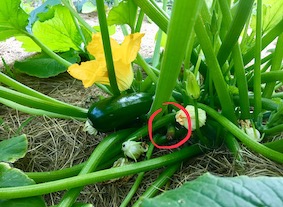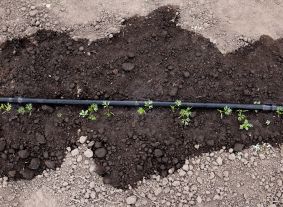Why Small Squash Rot on the Stem
Views: 2058

The first small squash and cucumbers that begin to grow on my plants each summer usually turn golden yellow (but not necessarily), then brown and then rot and fall off. I’ve thought nothing of it, really, aside from being momentarily curious and then promptly distracted by some weeds or another problem in the garden. I know that the squashes, zucchini and cucumbers will eventually produce by the bushel. If the first few are lost, that’s okay with me. I have other things to do.
I was recently part of a conversation, however, that sought to answer why those cucurbits turn yellow and rot. The others weren’t satisfied with “they just do,” and wanted to know the real reason. I had a few moments to learn something new , so I paid attention.
It’s About Pollination
The tiny, pinky-sized squash, zucchini, cucumbers and fruit of the other members of the cucurbit family turn yellow and die because they have not been pollinated. As a general rule, plants in the cucurbit family produce separate male and female flowers. When the pollen from the male flower doesn’t make it over to the stigma of the female flower, then the ovules contained by the female flower cannot be fertilized. No fertilization means no fruit is produced.
The Causes
What are the reasons for no or incomplete pollination?
- It could be the weather. Cool and cloudy days aren’t ideal times for the cucurbits’ main pollinator—the honeybee—to fly.
- Humidity can cause pollen to clump together, making it difficult for honeybees to transfer pollen.
- Excessive foliage can hide the cucurbit flowers or make it difficult for the pollinators to access the flowers.
- Pollinator populations in or around the plants and garden may be low or non-existent.
The Solutions
In my case, the first few potential squashes turn yellow and rot because the weather is cool. As the weather warms, fruit production is not an issue. But for the other causes listed above, we have a few solutions:
- Keep your squash or cucumber plants spaced far enough apart and remove leaves if you feel the leaf canopy may be hiding the flowers.
- Minimize pesticide usage that could kill or discourage honeybees from being in the garden.
- Plant some mid-sized to taller flowers in your garden to attract honeybees. They’ll eventually find their way to the squash flowers. If you can keep a hive, great!
You can try one more solution to be sure that pollen finds its way to your female flower. Pollinate the flowers by hand. I’ll describe the difference between male and female squash blossoms and explain how to pollinate by hand in the next edition of Just Veggies.
Meet Ellen Wells
When you’re raised on a farm, you can’t help but know a thing or two about gardening. Ellen Wells is our expert on edible gardening.…
Ellen's Recent Posts

Asparagus






